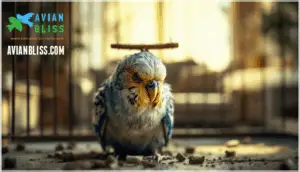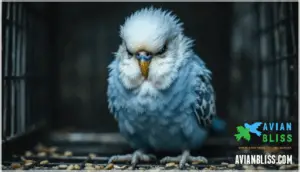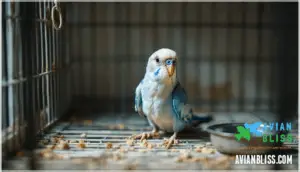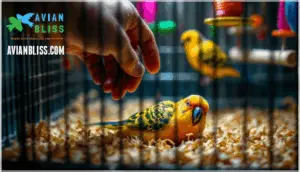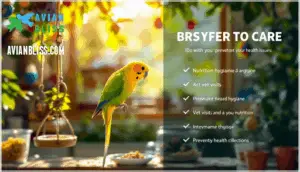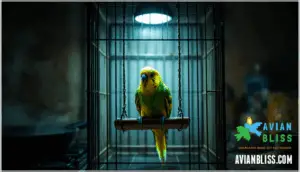This site is supported by our readers. We may earn a commission, at no cost to you, if you purchase through links.
 Your parakeet is lying at the bottom of the cage, feathers fluffed, breathing labored. In avian medicine, we call this the "point of no return" posture—when a bird finally shows distress, it’s been hiding illness for days, sometimes weeks. Parakeets are prey animals, hardwired to mask weakness until their bodies can’t compensate anymore.
Your parakeet is lying at the bottom of the cage, feathers fluffed, breathing labored. In avian medicine, we call this the "point of no return" posture—when a bird finally shows distress, it’s been hiding illness for days, sometimes weeks. Parakeets are prey animals, hardwired to mask weakness until their bodies can’t compensate anymore.
By the time they hit the cage floor, you’re racing against a clock that’s already run most of its course. The difference between life and loss often comes down to recognizing subtle warning signs before collapse and knowing exactly what to do in those critical first minutes.
Understanding why parakeets deteriorate so rapidly—and what kills them most often—gives you the knowledge to act fast when every second matters.
Table Of Contents
- Key Takeaways
- Signs Your Parakeet is Dying at Cage Bottom
- Common Causes of Parakeet Collapse
- Emergency Steps for a Dying Parakeet
- Preventing Parakeet Health Crises
- Environmental Hazards That Threaten Parakeets
- Caring for Your Flock After a Loss
- Frequently Asked Questions (FAQs)
- Why is my parakeet going to the bottom of the cage?
- What would cause a parakeet to die suddenly?
- What are the signs of a sick budgie?
- What to do when your budgie is dying slowly?
- How do I perform CPR on a dying parakeet?
- What are the signs of old age in parakeets?
- Can parakeets drown in their water bowls?
- How do I prevent night frights in my parakeet?
- What should I do if my parakeet stops eating?
- Can stress alone kill an otherwise healthy parakeet?
- Conclusion
Key Takeaways
- Parakeets are hardwired to hide illness until they’re critically weak, so by the time they collapse at the bottom of the cage, you’re often working with just 24 to 48 hours to intervene—making immediate recognition of subtle warning signs like fluffed feathers, labored breathing, and appetite loss your best defense against fatal outcomes.
- Respiratory infections account for roughly 65% of clinical cases in pet birds, with mortality rates climbing near 70% within a week without treatment, but getting your parakeet to an avian veterinarian within 24 hours of symptom onset cuts that risk in half.
- Environmental hazards like PTFE fumes from nonstick cookware, heavy metals from cage materials, and poor air quality cause over 70% of sudden parakeet deaths, yet most are completely preventable through careful household management and proper cage setup.
- Emergency stabilization—creating a warm space (85–90°F), providing hydration, and minimizing stress—buys critical time before veterinary intervention, but these comfort measures alone won’t save your bird without professional avian care addressing the underlying cause.
Signs Your Parakeet is Dying at Cage Bottom
When your parakeet is suddenly at the bottom of the cage, recognizing the warning signs can mean the difference between life and death. These birds are masters at hiding illness until they’re critically weak, so by the time symptoms appear, you’re often facing an emergency.
Here’s what to watch for when your parakeet shows signs of serious decline.
Lethargy and Weakness
When your parakeet is suddenly grounded at the bottom of the cage—barely moving, eyes half-closed, and unresponsive to your voice—you’re witnessing lethargy that signals a serious medical emergency. This energy depletion stems from common parakeet health issues affecting key organs.
Watch for these signs of health decline:
- Reduced activity and reluctance to perch normally
- Altered sleep patterns with excessive daytime drowsiness
- Muscle atrophy and deteriorating feather condition
These avian health red flags demand immediate veterinary attention.
Fluffed Feathers and Hunched Posture
If lethargy dims your bird’s spark, fluffed feathers and a hunched posture reveal just how hard their body is fighting to survive. This distinctive body language means your parakeet is trying to conserve heat and energy—classic illness signs that point to serious parakeet health issues.
When you notice this feather ruffling paired with hunched behavior, it’s your bird’s way of telling you something’s critically wrong. Posture analysis shows that healthy parakeets maintain sleek plumage and upright stances, so any deviation signals declining avian health.
Labored or Open-Mouth Breathing
Beyond the fluffed feathers and slumped posture, open-mouth breathing or a heaving chest tells you that your parakeet’s respiratory system is in crisis. Breathing difficulty causes range from air sac mites to aspiration pneumonia—common illnesses that rapidly escalate without emergency oxygen therapy.
Watch for these respiratory distress signs in pet birds health:
- Tail bobbing with each labored breath
- Audible wheezing or clicking sounds
- Extended neck stretching to inhale
- Flared nostrils during exertion
These health problems demand immediate veterinary intervention to restore bird health.
Changes in Droppings
Your bird’s droppings act like a daily report card—sudden changes in color, consistency, or frequency can reveal serious internal problems before other symptoms appear. Healthy droppings show three distinct parts: green or brown feces, white urates, and clear liquid. When you notice bloody droppings, undigested food, or watery consistency, collect a fecal sample and contact your veterinarian immediately—these are critical signs of health decline.
| Dropping Change | What It Indicates |
|---|---|
| Color (yellow, black, or red) | Liver disease, internal bleeding, or common illnesses |
| Consistency (watery or tarry) | Gastrointestinal infections or kidney dysfunction |
| Frequency (increased or absent) | Metabolic disorders affecting pet health |
| Undigested seeds visible | Malabsorption or digestive system failure |
Loss of Appetite and Weight Loss
When a parakeet stops eating or starts dropping weight, you’re watching a countdown clock—most birds instinctively hide illness until they’re critically compromised, often leaving you just 24 to 48 hours to intervene.
When parakeets stop eating, you’re watching a 24-to-48-hour countdown—they hide illness until critically compromised
Monitor these urgent feeding signals:
- Ignoring favorite foods – Dietary deficiencies or organ failure makes even treats unappealing
- Visible keel bone – Weight loss exposes the breastbone, indicating late-stage malnutrition
- Crop emptiness – Crop impaction or parasitic infections prevent normal digestion
- Regurgitation attempts – Metabolic diseases disrupt parakeet diet and nutrition absorption
Contact your avian vet immediately when these signs of health decline appear.
Common Causes of Parakeet Collapse
When your parakeet collapses at the bottom of the cage, several underlying health conditions could be to blame. Understanding these common causes helps you recognize warning signs and respond quickly when your bird needs help.
Let’s look at the specific health problems that can lead to a life-threatening collapse.
Respiratory Infections
Respiratory diseases make up about 65% of clinical cases in pet birds, making them the top reason parakeets collapse. Bacterial infections like Chlamydia and fungal problems such as aspergillosis account for roughly half of these cases.
Watch for open-mouth breathing and tail bobbing—these show up in 80% of birds with serious infections. Environmental factors, such as poor ventilation, can also contribute to the development of respiratory issues, so adequate ventilation is key.
Without treatment, mortality rates climb near 70% within a week, but getting your parakeet to an avian veterinarian within 24 hours cuts that risk in half.
Gastrointestinal Disorders
Digestive problems catch most bird owners off guard because the signs—like changes in droppings or subtle weight loss—don’t scream "emergency" until your parakeet is already in crisis. Crop impaction, psittacine proventricular dilatation, bacterial infections, and parasitic infestations can shut down digestion fast.
An avian diet lacking variety makes these parakeet common health issues worse, so consult your avian veterinarian immediately if your bird stops eating or produces abnormal droppings.
Liver and Heart Disease
Fatty liver disease and cardiac failure work silently in parakeets, often showing no obvious symptoms until your bird collapses at the bottom of the cage. High-fat seed diets increase your bird’s risk of fatty liver and organ enlargement, while genetic predisposition can trigger heart murmurs in certain budgie lines.
When to see a vet:
- Sudden difficulty breathing or exercise intolerance
- Abdominal swelling suggesting liver failure
- Unexplained lethargy despite normal eating habits
Your avian veterinarian can detect these parakeet health and wellness concerns through physical exams and blood work before they become fatal budgie common health issues requiring emergency parakeet veterinary care.
Toxicity and Poisoning
Your home might be hiding silent killers. PTFE fumes from nonstick cookware and heavy metal toxicity from cage materials cause over 70% of sudden parakeet deaths.
Chemical exposure to cleaning products, plant ingestion, and rodenticides trigger neurological symptoms and organ failure within hours. Ingesting items with toxic heavy metals can also lead to severe health issues.
An avian veterinarian can identify poisoning through clinical signs like labored breathing and abnormal droppings, but prevention beats treatment every time.
Trauma or Injury
A single collision with a window or a panicked midnight flutter can turn your parakeet’s world upside down—literally. Trauma causes internal bleeding, fractures, and head injuries that send birds spiraling to the cage floor.
Common trauma injuries requiring immediate veterinarian attention:
- Fracture management for broken wings or legs from falls
- Head trauma causing disorientation and loss of balance
- Bleeding control and wound care for lacerations
- Feather plucking injuries from cage-mate aggression
Contact an avian veterinarian immediately—quick intervention saves lives in bird care emergencies.
Emergency Steps for a Dying Parakeet
When you find your parakeet collapsed at the bottom of the cage, quick action can mean the difference between life and death. The first few minutes are critical, and knowing what to do helps you stay calm while giving your bird the best chance at recovery.
Here’s what you need to do right now to stabilize your parakeet before professional help arrives.
Creating a Warm and Quiet Space
When your parakeet collapses at the bottom of its cage, the first thing you need to do is get it somewhere warm—because a sick bird can’t regulate its own body temperature the way a healthy one can. Move it to a quiet location away from other parakeets, drafts, and household noise.
Use a heating pad on low or a desk lamp to maintain warmth around 85–90°F, but never overheat. Remove unnecessary cage accessories that might stress your bird, and keep soothing sounds to a minimum until you reach a veterinarian.
Providing Hydration and Supportive Care
Once you’ve got your bird warm and settled, dehydration becomes the next battle—sick parakeets stop drinking on their own, and even a few hours without water can push a fragile body past the point of recovery. Offer fresh water using a dropper or syringe (without forcing), or try electrolyte solutions designed for avian care.
Isolation benefits your parakeet by reducing stress while you monitor closely. Contact your veterinarian immediately—comfort measures help, but professional intervention saves lives.
Administering First Aid
If comfort measures and hydration aren’t turning things around, it’s time to think about what first aid can actually do—and what it can’t. First aid buys time, not miracles. Here’s what you can manage:
- Bleeding control: Apply gentle pressure with a clean cloth; avoid styptic powder unless you’re trained
- Fracture support: Immobilize the wing or leg with soft wrapping to prevent further injury
- Burn treatment: Cool the area with lukewarm water, never ice; cover with a clean cloth
- Shock management: Keep your parakeet warm, dark, and quiet to stabilize their system
These measures help, but professional avian veterinary care remains essential for survival.
Contacting an Avian Veterinarian
You’ve done everything right so far—first aid stabilizes, but now your parakeet needs someone who speaks their language: an avian veterinarian. Finding specialists takes urgency; call ahead to confirm they accept emergency transport cases. Many clinics offer telehealth consultations for initial assessments. Cost considerations vary widely, so ask about fees upfront. Follow-up care determines recovery odds, making prompt contact essential for your bird’s survival.
| Aspect | What to Do | Why It Matters |
|---|---|---|
| Finding Specialists | Search "avian veterinarian near me" or contact emergency clinics | General vets lack bird expertise |
| Emergency Transport | Keep your parakeet warm and dark during travel | Stress worsens their condition |
| Telehealth Options | Ask if initial consultation happens via video | Saves time for acute cases |
| Cost Considerations | Request pricing before arrival | Prevents financial surprises |
| Follow-up Care | Attend all scheduled appointments | Recovery depends on continued treatment |
Isolating The Sick Bird
Separating your sick parakeet from the flock isn’t just helpful—it’s critical for preventing disease spread and giving your bird the focused care it desperately needs. A quarantine setup keeps contagious conditions from ravaging your other birds while letting you monitor behavior closely. Think of it as creating a recovery zone where stress drops and healing can happen.
- Quarantine Setup: Use a separate, quiet cage with food, water, and a perch within easy reach for your weakened bird
- Stress Reduction: Dim lighting and minimal noise help your parakeet conserve energy for recovery
- Monitoring Behavior: Watch droppings, appetite, and breathing patterns—changes tell your veterinarian what’s working
- Hygiene Protocols: Wash hands between interacting with birds and use separate food bowls to prevent cross-contamination
- Gradual Reintroduction: Once recovered, introduce your parakeet back to the flock slowly to avoid triggering relapse
Preventing Parakeet Health Crises
The good news is that most health crises are preventable with the right approach. By focusing on a few key areas—cage hygiene, nutrition, vet care, exercise, and environmental safety—you can catch problems early and keep your parakeet thriving.
Let’s walk through each of these essentials so you know exactly what to prioritize.
Proper Cage Hygiene and Cleaning
Your parakeet’s cage is basically a petri dish if you’re not staying on top of cleaning—and that’s where half the health problems start. Spot-clean daily by removing soiled cage substrate, droppings, and uneaten food. Replace substrate and bedding weekly.
Wash food and water bowls every single day with hot water—dirty water is a breeding ground for bacteria. Disinfecting techniques matter too: use bird-safe disinfectants monthly on perches and cage bars. Clean toys regularly, rotating them to prevent buildup.
A properly maintained enclosure with fresh substrate isn’t just tidy—it’s life-saving.
Balanced Diet and Nutrition
Think of your parakeet’s diet as the foundation everything else rests on—skip it, and the whole structure crumbles. Malnutrition accounts for roughly 30% of pet parakeet deaths, so this isn’t minor stuff. A proper diet combines high-quality pellets with fresh vegetables like broccoli and carrots, providing essential nutrients your bird desperately needs.
Dietary deficiencies—especially lacking calcium or vitamin A—trigger organ failure and immune collapse. That’s why supplementation needs matter. Avoid toxic foods like avocado, salt, and chocolate entirely.
Your parakeet’s health depends on:
- Fresh water daily to prevent dehydration and disease
- Pellets plus produce for complete avian nutrition
- Consistent feeding schedules to maintain stable energy
Hydration importance can’t be overstated—dirty water kills faster than you’d think. When feeding parakeets, think variety and freshness. Your bird’s life literally depends on what lands in that food bowl.
Regular Veterinary Check-Ups
Here’s the thing—most pet owners don’t realize that regular vet visits catch problems before your parakeet ends up at the bottom of the cage. Annual care is your frontline defense. Early detection through diagnostic testing identifies infections, organ dysfunction, and nutritional deficiencies when they’re still treatable.
Your veterinarian monitors vaccination schedules and parasite control, checking for hidden issues like respiratory disease or liver damage. Think of preventative care as insurance—it’s far cheaper and easier than emergency intervention.
When to see a vet? At minimum annually, but bring your bird in immediately if you notice behavioral changes, appetite loss, or breathing problems. Bird health hinges on catching trouble early.
Exercise and Mental Stimulation
Bored parakeets don’t just sit around looking sad—they start breaking down, both mentally and physically. Without proper exercise and enrichment, your bird’s immune system weakens and behavioral problems spiral. That’s why flight time outside the cage matters so much. Aim for at least an hour daily in a safe, supervised space where they can stretch their wings fully.
Toy rotation keeps things fresh—swap out enrichment toys every few days so nothing becomes stale. Foraging opportunities (hiding food in toys or paper) tap into their natural instincts and combat boredom.
Social interaction with you is essential too. Training games like teaching "step up" or simple commands provide mental stimulation while strengthening your bond. Think of it this way: an active, engaged parakeet is a healthier parakeet.
Reducing Stress and Environmental Risks
Stress and environmental toxins are silent killers in the cage—they weaken your parakeet’s defenses before you even realize something’s wrong. Minimizing stress requires:
- Noise Reduction and Light Control: Keep your habitat in a quiet space away from loud appliances, and maintain a consistent 12-hour light-dark cycle to regulate their circadian rhythm
- Safe Toys and Social Interaction: Rotate enrichment regularly and spend time daily with your bird, but avoid overstimulation that triggers anxiety
- Routine Stability: Stick to predictable feeding times and cage cleaning schedules, since parakeets thrive on consistency
Remove airborne toxins like Teflon fumes and cleaning products—they’re responsible for up to 70% of sudden deaths. Your calm, controlled enclosure is their sanctuary.
Environmental Hazards That Threaten Parakeets
Your parakeet’s environment is just as critical to their survival as food and water. Unfortunately, many common household items and conditions can quickly become life-threatening.
Let’s walk through the specific environmental hazards you should know about and how to protect your feathered friend from them.
Airborne Toxins and Household Chemicals
Many household items silently threaten your parakeet’s life. Teflon-coated cookware releases fatal fumes above 280°C—sometimes killing birds within minutes. Ammonia, bleach, and phenol-based cleaners (like Lysol) damage airways at concentrations you can barely smell. Aerosol sprays, air fresheners, and scented candles pose acute respiratory risks. Lead and zinc from paint, solder, or batteries cause neurological collapse. Toxic plants like philodendrons release harmful crystals. Pesticides and rodenticides are equally dangerous. If a chemical smells strong to you, it’s already harming your parakeet’s delicate respiratory system.
Prevention means removing these hazards entirely from your pet care environment.
Poor Air Quality and Carbon Monoxide
While you’re eliminating visible toxins from your bird’s environment, there’s an invisible threat lurking that’s equally—if not more—dangerous: the air your parakeet breathes every single day. Poor ventilation traps stale air and concentrates harmful particles, while carbon monoxide (CO) from faulty heating systems or nearby traffic poses an acute risk. Your parakeet’s respiratory system is incredibly sensitive—exposure to just 200 ppm of CO can cause fatal distress within minutes.
Beyond CO, consider these critical air quality factors:
- Ventilation needs: Provide fresh air circulation without drafts; stagnant air breeds bacteria and respiratory disease
- Air purifiers: HEPA filters reduce dust and allergens; avoid ozone-producing models
- Safe products: Choose bird-safe cleaning supplies; standard household cleaners concentrate toxins in enclosed spaces
- CO detection: Install detectors in your home; your parakeet may collapse before you notice symptoms
Regular cage placement away from kitchens and poorly ventilated areas, combined with monitoring air quality, protects your pet from these invisible killers.
Unsafe Cage Materials and Accessories
Now that you’ve sealed off the invisible threats, it’s time to look at what’s actually touching your parakeet every day—because the cage itself can be just as dangerous as the air around it. Toxic metals like zinc and lead leach into your bird’s system through chewed cage bars and accessories, causing organ damage. Plastic toys and perches break down with wear, creating choking hazards and releasing harmful compounds. Sharp edges and rough surfaces injure delicate feet and feathers, inviting infection. Improper cage sizing restricts movement, triggering stress and illness.
Choose stainless steel enclosures, natural wood perches, and smooth, bird-safe accessories to protect your parakeet’s wellbeing.
Temperature Extremes and Drafts
If you’ve nailed down the cage setup itself, you’re already ahead of the game—but here’s what many people miss: parakeets are surprisingly sensitive to temperature swings and air currents that can wreak havoc on their small bodies.
Your bird thrives between 65–80°F; anything colder triggers hypothermia, while heat above 85°F causes dangerous overheating. Drafts from windows, doors, and AC units stress their systems a great deal. Position your cage away from temperature extremes and air currents.
Watch for fluffed feathers, lethargy, or rapid breathing—these signal distress.
Caring for Your Flock After a Loss
Losing a parakeet is never easy, but how you approach the aftermath matters for both your emotional well-being and the health of any remaining birds.
The next few steps will guide you through grieving, safely disposing of your pet, protecting the rest of your flock, and deciding what comes next.
Let’s walk through each of these important considerations.
Handling Grief and Emotional Support
Losing a parakeet hits harder than many people expect. Research shows about 47% of pet owners experience declining emotional health after their bird passes, and roughly 40% feel isolated because others don’t grasp the depth of that bond. Your grief is legitimate—these small companions develop distinct personalities and routines woven into daily life.
Consider these support strategies:
- Connect with pet loss support groups (60% of participants report improved coping skills)
- Create memorialization practices like photos or small ceremonies (used by 63% of grieving owners)
- Seek grief counseling if sadness persists beyond a few months
- Allow yourself time rather than rushing to replace your bird
Maintaining "continuing bonds"—holding onto good memories—actually helps you heal better than trying to forget. A supportive environment where your grief is acknowledged reduces prolonged distress by 31%.
Safe Disposal of Deceased Parakeet
After you’ve said goodbye, treating your parakeet’s remains with care and respect becomes an important final act of love. You have several ethical options available, each reflecting your values around pet ownership and animal welfare.
| Disposal Method | Considerations |
|---|---|
| Home Burial | Check local regulations; choose a secure, undisturbed location away from water sources |
| Pet Cremation Services | Professional, respectful option; ashes can be memorialized or scattered |
| Veterinary Disposal | Your avian vet can treat remains; ask about their process and costs |
| Composting | Some regions allow pet composting; research legal considerations in your area |
Whatever you choose, this final act honors the bond you shared with your parakeet.
Cleaning and Disinfecting The Cage
Once the cage is empty, deep cleaning becomes your chance to stop any disease from spreading to your other birds. Use bird-safe disinfectants—avoid bleach or harsh chemicals that leave toxic residues. Remove all cage material and accessories, then scrub surfaces thoroughly with hot water.
Disinfect water and food bowls daily going forward. A complete cage cleaning schedule every week, with spot-cleaning between days, prevents buildup of harmful bacteria. Pay special attention to perches and corners where debris accumulates. This thorough enclosure maintenance protects your remaining flock’s health.
Quarantine for Remaining Birds
Your remaining birds are counting on you to be their first line of defense, so quarantine isn’t just about following protocol—it’s about protecting the flock you have left.
Here’s your isolation protocol:
- Separate sick or exposed parakeets into a different cage away from healthy birds for at least 2-4 weeks of quarantine duration.
- Monitor flock behavior daily for signs of illness—lethargy, ruffled feathers, or breathing changes warrant immediate veterinary attention.
- Care for quarantined birds last during parakeet care routines to prevent cross-contamination between cages.
- Apply preventative treatment as directed by your avian vet, including supportive nutrition and environmental adjustments.
Complete cage disinfection between bird groups protects your pet birds’ health long-term.
Deciding on New Parakeet Companions
Grief takes its own timeline, but at some point, you’ll notice the quiet in your home feels less like mourning and more like readiness. Before choosing parakeets, complete a full quarantine period for remaining pet birds and evaluate your flock dynamics—a calm bird pairs well with gentle companions, while energetic ones need playful matches.
| Factor | What to Consider | Why It Matters |
|---|---|---|
| Quarantine Period | Wait 4-6 weeks after loss | Ensures disease hasn’t spread to your flock |
| Personality Compatibility | Match energy levels and temperament | Prevents bullying and stress during socialization |
| Space Requirements | Add 18" width per parakeet | Overcrowding triggers aggression and health issues |
| Introduction Methods | Use neutral territory, gradual exposure | Smooth transitions protect flock dynamics |
Proper planning makes new companions feel like family, not intruders.
Frequently Asked Questions (FAQs)
Why is my parakeet going to the bottom of the cage?
When parakeets rest on the cage floor, they’re often signaling distress rather than choosing a cozy spot. Leg weakness, respiratory illness, or psychological distress commonly drive this behavior.
Healthy birds instinctively perch—grounding themselves suggests something’s wrong with their health.
What would cause a parakeet to die suddenly?
Sudden death in parakeets often traces back to undetected illnesses, environmental dangers like airborne toxins, or nutritional deficiencies. Behavioral changes preceding death signal underlying problems. Proper parakeet care extends lifespan and considerably reduces these risks.
What are the signs of a sick budgie?
Healthy budgies are active, vocal, and alert. Watch for feather changes like fluffing or plucking, appetite decline, breathing problems (labored or open-beak), dropping abnormalities in color or consistency, and reduced activity level—these signal illness requiring immediate veterinary attention.
What to do when your budgie is dying slowly?
Palliative care focuses on comfort measures when curative treatment isn’t possible.
Keep your parakeet warm, quiet, and hydrated while you monitor quality of life closely.
Contact an avian veterinarian immediately to discuss pain management, supportive care, or humane euthanasia options to prevent suffering.
How do I perform CPR on a dying parakeet?
True CPR for parakeets isn’t feasible—their delicate bones shatter under chest compressions, and rescue breaths risk lung rupture. Recognizing cardiac arrest means immediate transport to an avian vet.
Post-CPR care for pet birds requires professional emergency care, not home intervention.
What are the signs of old age in parakeets?
As parakeets age—usually around 7 to 10 years—you’ll notice reduced activity levels, joint stiffness affecting perch grip, dull feather quality, appetite changes, and sometimes cataracts clouding their eyes.
These gradual shifts reflect normal aging in adult-sized birds.
Can parakeets drown in their water bowls?
While extremely rare, drowning can happen if your parakeet is severely weakened or unconscious. Healthy parakeets won’t drown in typical water dishes—they’re surprisingly savvy swimmers.
Keep water height shallow (about one inch) and guarantee stable perch placement nearby for safe access during drinking or bathing sessions.
How do I prevent night frights in my parakeet?
Cover your parakeet’s cage partially at night using breathable fabric, leaving ventilation. Keep a dim night light nearby to prevent disorientation.
Secure perches properly and maintain a consistent sleep routine to minimize stress and reduce night frights.
What should I do if my parakeet stops eating?
Watch closely—a parakeet refusing food needs urgent attention. Appetite loss signals serious illness affecting your parakeet’s lifespan.
Offer variety like millet sprays or warm vegetables to tempt appetite. Try hand feeding or gentle syringe feeding if weakness prevents eating. Check for crop issues like swelling.
Schedule an immediate vet consult.
Can stress alone kill an otherwise healthy parakeet?
Yes, chronic stress can be fatal. Stress-induced mortality occurs when prolonged stress overwhelms a parakeet’s immune system, leaving it vulnerable to infections and organ failure.
While healthy parakeet resilience is strong, repeated disturbances erode their defenses quickly.
Conclusion
Like the canary in the coal mine, your parakeet’s collapse is rarely the beginning—it’s the final alarm in a crisis already underway. The bird lying at the bottom of the cage has been fighting silently, and your response in those first critical hours determines whether you’re providing comfort or creating a chance at recovery.
Learn the whispers before the collapse, keep an avian vet’s number within reach, and remember: prevention isn’t paranoia when you’re responsible for a creature that hides its pain until hiding becomes impossible.
- https://lafeber.com/pet-birds/questions/sudden-deaths/
- https://www.zumalka.com/blogs/blog-pet-health/vet-insights-common-parakeet-health-problems
- https://timesofindia.indiatimes.com/life-style/relationships/pets/8-toxic-foods-you-should-never-feed-your-parakeet-for-safe-nutrition/articleshow/124411908.cms
- https://www.merckvetmanual.com/bird-owners/disorders-and-diseases-of-birds/disorders-affecting-multiple-body-systems-of-pet-birds
- https://www.cdc.gov/psittacosis/about/index.html

